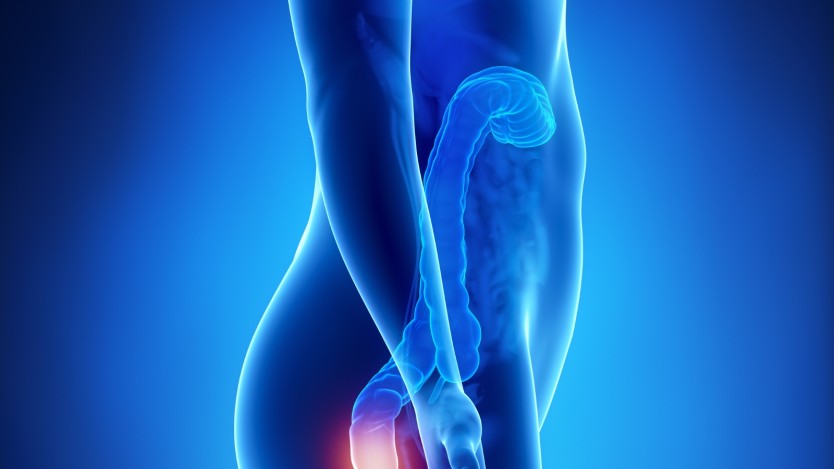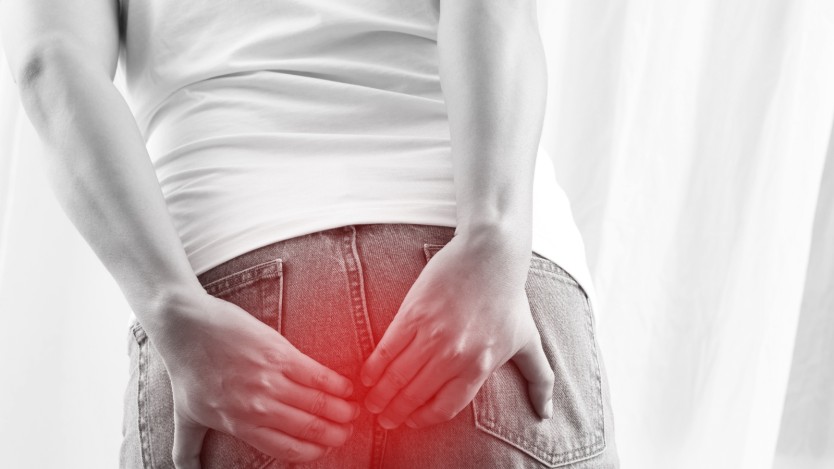Fissure in the anus: causes, symptoms and treatments

- What is an anal fissure?
- Causes of an anal fissure
- What are the symptoms of an anal fissure?
- Diagnosis of an anal fissure
- Possible treatments for anal fissure
- What is the recovery period like after anal fissure surgery?
- Request a surgical assessment consultation with Operarme
- A fissure in the anus can be acute, if it lasts less than two months and we have never had it, or chronic if it has reproduced or lasts more than 8 weeks.
- The causes of a fissure in the anus can be primary, if it is due to mechanical factors, or secondary if it is the result of a disease.
- The treatment for anal fissure is surgical in most cases, but there are other types of treatment for particular cases.
What is an anal fissure?
A fissure in the anus is a tear in the mucosa of the walls of the intestine, more specifically in the final portion occupied by the rectum and anus. This type of lesion causes intense pain and discomfort, and its origin varies.
Patients sometimes confuse the symptoms of a fissure in the anus with haemorrhoids or fistula, which is why it is important that the diagnosis is made by a specialist in general and digestive system surgery.

Do you need anal fissure surgery?
Request a free and immediate appointment with our specialists in General Surgery
Fissures usually occur at the back of the anus because the surrounding tissue is a mucosal layer that is weaker than the skin around it and is easily broken. This is an area that bears great pressure during the evacuation of faeces and the area that withstands tension when some of the sphincters that close and open the anal canal contract and relax.

Types of anal fissure
Anal fissures can be differentiated according to their cause and time of evolution. Based on the above factors, there are two classifications.
Depending on how long they have been present:
- Acute anal fissure: These are fissures that have been present for less than 6 weeks and you have never had an anal fissure before or at least in the last 2 years.
- Chronic anal fissure: If you regularly suffer from anal fissures always in the same area or it lasts more than 6 weeks despite conservative medical treatment.

According to the causes for which they appear:
- Primary or idiopathic anal fissure: This type of fissure is caused by mechanical factors, i.e. due to movement disorders and the type of stool (too hard or frequent diarrhoea) that damage the anal canal. In other cases, the cause is unknown.
- Secondary anal fissure: In this case, the appearance of a fissure is due to a systemic disease, the consequence of which is the appearance of anal fissures. The most common diseases are Crohn's disease, ulcerative colitis, intestinal tuberculosis or sexually transmitted diseases.
In the following section you can find detailed information on the causes of anal fissures, and if you need more information on this condition you can consult the article on Anal fissures: types, diagnosis, symptoms and treatment.
Causes of an anal fissure
Fissures in the anus are classified as primary or secondary depending on whether their appearance is due to a tear in the anal mucosa due to trauma, primary, or whether it is due to a systemic disease that leads to weakness of the mucosa lining the intestine and consequently to the appearance of the fissure.
Primary anal fissure
In general, a primary anal fissure is due to a small trauma or a combination of many traumas, the causes of which can be diverse:
- Constipation: When a person is constipated and this is prolonged over time, each time the patient defecates, the combination of the effort required and the lack of lubrication of the anal canal, which implies the need for this effort, gradually damages the mucosa lining the rectum and anus. If this constipation is prolonged over time without a solution, it is possible that damage to the mucosa and the consequent appearance of the fissure in the anus may occur.
- Diarrhoea: Completely contrary to the cause explained in the previous paragraph, if the patient suffers from abundant and frequent diarrhoea, the liquid faeces and its contents can cause a chemical burn in the mucosa of the anal canal, weakening it and causing the tear known as anal fissure.
- Anal sex: In the same way that the microtrauma suffered by the anal canal during constipation can lead to the formation of a fissure in the anus, anal sex, both conventional and with the introduction of elements foreign to the human body into the anal canal, can cause the mucosa to tear, forming a fissure in the anus. Therefore, it is important to perform this type of sexual practices with good lubrication and care to avoid this problem.

Secondary anal fissure
As we have already mentioned, anal fissures of secondary origin are due to diseases of the digestive system that can cause them as a consequence. Although they are not excessively common, these diseases are:
- Inflammatory Bowel Diseases: Crohn's Disease and Ulcerative Colitis
- Intestinal tuberculosis
- Sexually transmitted diseases, the most common being syphilis.
All these diseases can cause the appearance of a fissure in the anus by weakening the intestinal mucosa, the rupture of which produces this uncomfortable and annoying anal lesion.
For the treatment of this type of anal fissure, it is important to know first if it is due to any of the diseases mentioned above, as their treatment is vital to prevent recurrence of the fissure.
What are the symptoms of an anal fissure?

After onset, you may have various signs and symptoms that cause discomfort and discomfort that worsen over time, which is why it is important to detect them as soon as possible and start treatment.
The most common symptoms include the following:
- Pain: Pain is perhaps the quintessential symptom of an anal fissure. It is a lancinating pain, as if you were being cut with a knife on the inside of the intestine, which occurs when faeces pass through the anal canal. Afterwards, the patient suffers pain for a few minutes, although in some cases it can last for hours, and then feels warmth or burning in the area.
- Sphincter contracture: This symptom of anal fissure affects the patient throughout the day and consists of the sensation of heaviness or discomfort that patients feel, whether it is chronic or acute anal fissure. This sphincter contracture is due to the fact that when suffering intense pain during defecation, the sphincter closes, aggravating the patient's constipation. This aggravates the problem, as the stool becomes extremely hard and damages the anal canal even more, causing the fissure to become chronic.
- Anorectal bleeding: This symptom of anal fissure is due to the friction that occurs during the passage of faeces along the damaged anal mucosa. This bleeding is usually small in quantity and bright red in colour, which indicates that it is a problem caused in one of the lower parts of the intestine, since if the bleeding were darker it would imply that the problem was in the upper parts of the intestine. In addition, because of the area where the fissure is located, infections are quite common, which means increased pain and discomfort.
Diagnosis of an anal fissure
To diagnose an anal fissure, if indicated, the specialist will perform a digital rectal examination. This physical examination involves inserting a gloved finger or a small lighted tube through the anal canal to examine the area. If you have a lot of pain and discomfort, the doctor will be able to diagnose you simply by observation.
If the specialist considers that you may have an undiagnosed disease, he/she will recommend further tests such as:
- Flexible sigmoidoscopy: This test involves the introduction of a thin, flexible tube with a small camera into the inner part of the colon. This type of examination is only recommended if you do not have intestinal diseases or colon cancer, and if you are under 50 years of age.
- Colonoscopy: With this test, the colon is inspected by inserting a flexible tube into the rectum. Unlike the previous test, this one is possible if you are over 50 years old or if you have risk factors for colon cancer and signs of other conditions such as abdominal pain or diarrhoea. In the following link you will find everything you need to know about colonoscopy: Colonoscopy, what it is used for and the problems it diagnoses.
Possible treatments for anal fissure
Treatments for an anal fissure depend on the severity of the fissure, whether it is a primary or secondary anal fissure and whether or not it has responded to more conservative treatments. Below we explain some of the anal fissure treatments that are commonly used:
Conservative treatment of an anal fissure

The most common anal fissures are primary fissures in healthy patients, which is why conservative treatmentis usually chosen in the first instance. The idea behind this type of treatment is to minimise the microtrauma to the damaged anal canal during the passage of faeces. Almost all of these measures are common in the treatment of the various existing anal pathologies.
To this end, a series of instructions provided by the doctor should be carried out, such as the following:
- Fibre-rich diet: The aim of this is to fragment the faeces, facilitating their passage through the anal canal and reducing the friction that occurs with the walls of the intestine and, consequently, with the anal fissure, so that it heals on its own.
- Sitz baths with warm water: Sitz baths aim to relax the symptom of internal sphincter contraction to prevent the constipation that aggravates the fissure.
- Application of ointments: These ointments contain local anaesthetics and anti-inflammatory drugs, which lubricate the anal fissure, reducing trauma and reducing inflammation in the area.
If symptoms persist or continue to worsen, your specialist may recommend drugs to help eliminate the problem.
Non-surgical treatment of anal fissure

For this treatment you will be prescribed ointments containing local anaesthetics and anti-inflammatory drugs, which lubricate the anal fissure, reducing trauma while reducing inflammation in the area. You may be recommended medicines such as:
- Nitroglycerin for external application: This type of drug is used to improve healing, increase blood flow and promote sphincter relaxation.
- Injections of butolinic toxin type A (Botox): These injections help to reduce spasm and paralyse the anal sphincter muscle.
- Anaesthetic cream: These are ointments containing lidocaine hydrochloride, which relieve pain and discomfort in the area.
- Drugs to relieve blood pressure: Some drugs, such as nifedipine or diltiazem, can help relax the sphincter. You should know that you can take them orally or apply them in the form of an ointment to the external area of the fissure. They should be prescribed by a specialist doctor.
However, if conservative treatment does not work, or if you have a chronic anal fissure, the best and most effective treatment is surgery. You can find more information about surgery below.
Surgical treatment of anal fissure: sphincterotomy
Although, as we have mentioned, there is an initial conservative treatment to try to solve the problem of anal fissure, not all patients manage to alleviate the problem in this way, so the only possible option is anal fissure surgery.

The surgical technique usually used to alleviate the symptoms of a fissure in the anus is sphincterotomy, more specifically lateral internal sphincterotomy. The aim of this intervention is to relax the existing sphincter hypertonia so that the fissure can heal:
Fissure repair in the anus: step by step
- The anal fissure operation is performed under spinal anaesthesia and sedation.
- The surgeon will dilate the anus using a bivalve anal retractor, allowing the surgeon to observe the anal fissure from the outside.
- Then, after locating the groove that divides the inner and outer portion of the sphincter, he will make an incision in the inner lateral area of just over 2-4 mm with a scalpel or electric scalpel.
- The duration of the surgery is between 15-20 minutes, and the patient can leave the hospital the same day or within 24 hours.
- Symptom improvement is immediate in most cases.
- The recurrence of anal fissures after sphincterotomy is very low, making it a safe and efficient technique.
After the surgery, you will be transferred to your room where you will recover from the effects of the anaesthesia and where you will receive all the necessary care until you are discharged from hospital.
You will stay in the operating theatre for between 15 and 30 minutes, and you can leave the hospital the same day or after 24 hours. You should also know that you will notice an improvement in your symptoms almost immediately.
What is the recovery period like after anal fissure surgery?
After the surgery and at home, you will move on to the recovery period. Generally, the postoperative period lasts from 3 to 4 weeks, depending directly on the severity of the fissure and the complexity of the surgery, until complete healing is achieved.
In any case, as we mentioned earlier, the discomfort will disappear day by day. You will notice how the healing is gradually completed.
To complete the recovery period as soon as possible, you should follow the care instructions and take the medication that the specialist has prescribed.
If you would like more details about this stage of healing, you can consult the following articles:
Request a surgical assessment consultation with Operarme
If you have problems in your daily life due to an anal fissure and you are thinking of having surgery with us, you can request a free surgical assessment consultation with one of our specialists in General and Digestive Surgery.
You can request a surgical assessment consultation by clicking below:

Do you need anal fissure surgery?
Request a free and immediate appointment with our specialists in General Surgery
Medical disclaimer: All the published content in Operarme is intended to disseminate reliable medical information to the general public, and is reviewed by healthcare professionals. In any case should this information be used to perform a diagnosis, indicate a treatment, or replace the medical assessment of a professional in a face to face consultation. Find more information in the links below:
